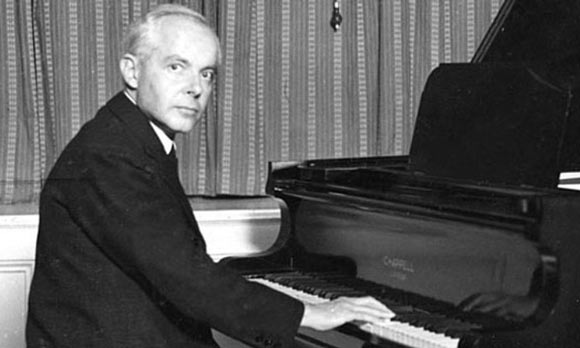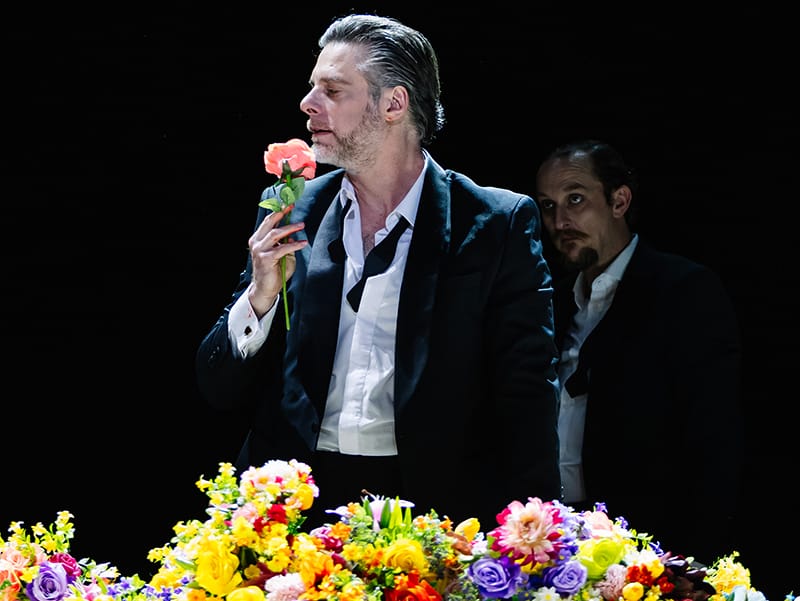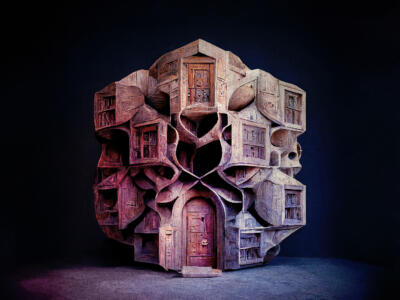
Béla Bartók
(born Nagyszentmiklós, Hungary 25 March 1881; died New York 26 September 1945)
Born a proud Hungarian (though his birth town is now within the borders of Romania), Béla Bartók belongs to the extraordinary generation of modernist European composers who came to the fore at the beginning of the 20th century – which included Schoenberg, Berg and Webern (the Second Viennese School), Stravinsky and Varèse. Together with his compatriot, Zoltan Kodály, Bartók forged a ‘Hungarian’ musical style that drew inspiration from native folk song, yet also had a modernist edge. Like Vaughan Williams in England, Bartók collected and transcribed folk music.
Discover more about Béla Bartók within this guide, as we delve into some of his most famous music, orchestral works, ballet pieces and opera compositions. You’ll also find a short biography of Bartók’s life as a composer, along with interesting facts and the answers to questions frequently asked about him.
The life of Béla Bartók: A summary
In this section we will look at Bartók’s upbringing in Hungary, as well as his main achievements, career and later life.
Early life and education
Béla Bartók was born in Nagyszentmiklós (now Sânnicolau Mare, Romania) on the 25th March 1881, his father, also called Béla, was Director of an Agricultural School and a descendant of a Hungarian lower noble family whilst his mother Paula was originally from Turócszentmárton (present-day Martin, Slovakia) and had German, Hungarian, Slovak and Polish ancestry. He had one sister, called Erzsébet.
Both Béla Bartók’s parents were keen amateur musicians who encouraged their son’s musical interests. Though no child prodigy, Bartók began having piano lessons at the age of five, and his first compositions – short, folk-inspired dances and small piano pieces – came four years later. Béla was a frail child and after his father died suddenly, when he was seven, his mother took him and his sister to live in Nagyszőlős. Here, Béla gave his first public performance at the age of 11. His recital – which included one of his own compositions called, The Course of the Danube – received a positive critical reception and soon after he was accepted as a pupil by László Erkel (son of Ferenc Erkel, Hungary’s first important operatic composer).
Bartók continued with his musical studies throughout his teenage years and, aged 17 in 1898, was accepted into the prestigious Vienna Conservatoire. However, already politicised to the Hungarian nationalist cause, Bartók chose to remain in Budapest, where he studied piano and composition at the Budapest Academy of Music where he graduated in 1903.
During his time at the Academy he established himself as a renowned pianist rather than a composer and after a two-month tour of Spain and Portugal, he was appointed to a position as a piano teacher, later replacing his own teacher, István Thoman, as professor of piano at the Academy.
Career highlights
Bartók’s earliest mature compositions include the Expressionist one-act opera, Duke Bluebeard’s Castle – his only opera, whose fluid setting of the text owes much to the composer’s experience of folk music – and The Miraculous Mandarin, a ballet (labelled a ‘pantomime’ by the composer) in which Bartók’s mastery of orchestration is on full show.
Continuing to be heavily influenced by traditional folk music, in 1915, Bartók composed his Romanian Folk Dances a suite of six pieces based on folk music that would originally have been played on the fiddle. Béla wrote the set for solo piano, however they were re-worked for orchestra two years later.
The impact of the First World War that followed this period meant that Bartók had to re-establish his international reputation once the war was over and at the age of 41, Bartók embarked on a series of international concert tours, though he always had a diffident platform manner.
In the 1920s and 1930s, he penned many of his finest pieces, including: his String Quartets Nos. 3–6, the Cantata Profana (1930), the Sonata for Two Pianos and percussion (1937), the Violin Concerto No. 2 (1938), the Piano Concertos No.1 and No.2, and the Music for Strings, Percussion and Celesta (1936). His prowess as a pianist was to serve him well throughout his life, and he appeared in recitals and concerts across Europe and later in the United States, often playing his own works, and formed a duo-partnership with his second wife, Ditta Pásztory, to whom he dedicated his Third Piano Concerto.
During these two creative decades, Bartók continued to teach at the Budapest Academy of Music until his resignation in 1934 after which he devoted much of his time to ethnomusicological research.
Expanding his studies beyond the traditional Hungarian folk music that he loved, Béla began to include other ethnic traditions from Transylvania, Romania and North Africa, leaving behind a legacy as one of the founders of ethnomusicology and study of comparative musical folklore in Hungary.
Later life
With the worsening European political situation in the 1930s and the rise of Fascism, Bartók sought refuge in the United States, settling in 1940 in New York where he taught at Columbia University. Despite diminishing financial resources and declining health – he was treated for polycythemia – he continued to compose, completing the celebrated Concerto for Orchestra (1943), the Piano Concerto No.3 (1945), a Sonata for Solo Violin (commissioned by Yehudi Menuhin in 1943), and a Viola Concerto (composed in 1945 and premiered posthumously).
Bartók died in New York in 1945, at the age of 64, from complications of leukaemia, which had been diagnosed a year earlier. Only ten people attended his funeral, including his wife and two sons. Originally buried in Hartsdale, New York, his remains were exhumed and re-interred in 1988 at the request of his sons. The Hungarian government honoured Bartók with a state funeral and he was buried alongside his second wife, Ditta.
Bartók’s musical style and influence
The rhythmic, melodic and harmonic profiles of Hungarian folk song and other traditional music lie at the roots of Bartók’s musical language, even when they are not surface elements. Exposure to major figures such as Richard Strauss (especially his tone poems) and Debussy’s piano music, as well as Schoenberg and Stravinsky, all made an impact on Bartók.
He adapted the romantic musical expression of his earliest works in favour of more folk-based style, wanting his works to reflect his belief in Hungarian nationalism. While Bartók claimed his music was ‘tonal’, it rarely uses conventional chords or scales, and he readily acknowledged the influence of American composer Henry Cowell’s use of tone clusters as an important influence. Formal structure in Bartók’s music is an important element, with a significance accorded to ‘golden’ ratios, i.e., specific ratios of numbers of bars to the different sections of a movement or work.
Bartók’s music most influenced his near-contemporary, Kodály, and together they are regarded as the founding fathers of Hungarian 20th-century music, whose successors are figures such Ligeti and Kurtag. Outside Hungary, Bartók’s music influenced composers as different as Messiaen, Lutosławski, Britten and Copland.
Bartók's most famous works
- Duke Bluebeard’s Castle (1911, rev. 1918) – opera
- The Miraculous Mandarin (1918–19) – ballet
- Three Piano Concertos (1926; 1930–1; 1945)
- Mikrokosmos for piano(s) (1926; 1932–9), largely composed for Bartók’s son Péter’s music lessons
- Music for Strings, Percussion and Celeste (1936)
- Six String Quartets (1908; 1915–17; 1927; 1928; 1934; 1939)
- Concerto for Orchestra (1943)
Find out more about ENO productions past and present on our Discover Opera page.
FAQ's
Who is Béla Bartók?
Béla Bartók was a Hungarian born Composer and Pianist. Often considered one of the most important composers of the 20th Century, both he and Franz Liszt are regarded as Hungary’s greatest composers.
Where is Béla Bartók from?
Béla Bartók was born in Nagyszentmiklós in what was formerly Hungary on the 25th March 1881. However he later moved with his mother and sister to live in Nagyszőlős (present-day Vynohradiv, Ukraine).
How do you pronounce Béla Bartók?
The correct way to pronounce Béla Bartók is ‘bee-la bar-tok‘
What is Béla Bartók most famous for?
Béla Bartók is most famous for his piano compositions which included the Sonata for Two Pianos and percussion (1937), the Violin Concerto No. 2 (1938), the Piano Concertos No.1 and No.2, and the Music for Strings, Percussion and Celesta (1936).
What instruments did Béla Bartók play?
Béla Bartók’s parents were both amateur musicians and they taught him to play both the drums and piano from a very young age. Béla excelled at piano in particular and by the age of four had learned around forty pieces of music and by the age of ten he had begun composing.
How did Béla Bartók die?
Béla Bartók died in September 1945, in New York City, aged 64 from complications of leukemia. Bartók’s body was initially interred in New York, however in the late 1980’s the Hungarian government, along with his two sons, Béla III and Péter, had his remains exhumed and transferred back to Budapest for burial. Hungary held a state funeral for him on 7 July 1988.



